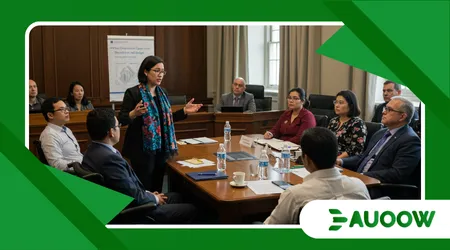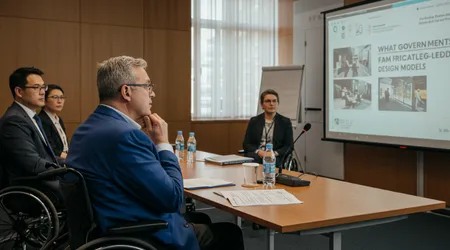What Governments Can Learn from Disability-Led Design Models

Disability-Led Design Models are reshaping how we think about inclusion, accessibility, and innovation in public policy.
Imagine a world where public spaces, services, and systems are crafted not just for the majority but with the direct input of those who navigate unique challenges daily.
This isn’t a utopian dream it’s a practical approach governments can adopt to create equitable societies. By centering people with disabilities in the design process, policymakers can build systems that are more intuitive, resilient, and universally beneficial.
This article explores how Disability-Led Design Models offer transformative lessons for governments, drawing from real-world examples, data, and innovative practices as of 2025.
Why should governments prioritize voices that are often sidelined? The answer lies in the profound impact of inclusive design on everyone.
The journey to inclusive public policy begins with understanding that disability is not a niche issue it’s a universal human experience. According to the World Health Organization, 1.3 billion people globally live with a disability, roughly 16% of the population.
Governments have a responsibility to serve all citizens, yet traditional policymaking often overlooks the expertise of those with lived experience.
Disability-Led Design Models flip this script, ensuring that people with disabilities lead the creation of solutions, resulting in policies that are not only accessible but also innovative and efficient.
This article delves into key lessons governments can learn, from fostering collaboration to rethinking infrastructure, with practical examples and actionable insights.
The Power of Lived Experience in Policy Design
When people with disabilities guide policy creation, the results are transformative. Disability-Led Design Models prioritize lived experience, ensuring solutions address real needs.
For instance, in San Antonio, Texas, the Housing Trust collaborated with disabled residents to develop Multi-Family Universal Design Standards in 2024. These standards, informed by direct input, ensure housing accommodates diverse mobility and sensory needs.
This approach contrasts with top-down policies that often miss the mark. By involving disabled individuals, governments gain insights into barriers that data alone can’t reveal.
++ How to Join Public Consultations About Accessibility Laws
The San Antonio model shows how co-design leads to practical, scalable solutions that benefit everyone, not just those with disabilities.
Moreover, lived experience fosters empathy in policymaking. When disabled voices lead, policies reflect nuanced realities, like the need for sensory-friendly public spaces.
This creates environments where everyone thrives, proving that inclusion drives universal benefits.

Redefining Accessibility Through Collaboration
Collaboration is at the heart of Disability-Led Design Models. Governments must partner with disabled communities to create policies that work.
In 2025, Washington, D.C.’s Qualified Allocation Plan incentivizes developers to adopt Inclusive Design Standards, rewarding projects that prioritize accessibility through community input.
Such partnerships ensure policies are practical and sustainable. For example, involving wheelchair users in urban planning can lead to curb cuts that benefit parents with strollers too. Collaboration transforms accessibility from a checkbox to a dynamic process.
This model also builds trust. When governments listen to disabled advocates, they signal that all voices matter. This trust fosters civic engagement, strengthening democratic processes and community resilience.
Also read: The Role of Disability Impact Assessments in Urban Policy
Infrastructure That Works for Everyone
Disability-Led Design Models reveal that accessible infrastructure benefits all. Consider the analogy of a river: a single dam blocks everyone downstream, but a clear path lets all flow freely.
Curb cuts, initially designed for wheelchair users, now ease navigation for cyclists, delivery workers, and parents.
In 2024, Teton County, Wyoming, integrated Inclusive Design Standards into its Livability Standards, ensuring new housing accommodates diverse needs. This proactive approach prevents costly retrofits and enhances community livability.
Read more: How Disability Is (Mis)treated in Social Welfare Policies
Governments can learn to prioritize universal design from the outset. By consulting disabled designers, infrastructure becomes intuitive, reducing barriers and enhancing efficiency for all citizens.
Data supports this: a 2023 study by The Kelsey found that accessible housing increases property values by 8% due to broader market appeal. Investing in universal design is both equitable and economically smart.
| Metric | Traditional Design | Disability-Led Design |
|---|---|---|
| Cost of Retrofitting | High | Low |
| User Satisfaction | Moderate | High |
| Market Appeal | Limited | Broad |
| Compliance with ADA Standards | Partial | Full |
Technology as a Catalyst for Inclusion
Technology amplifies the impact of Disability-Led Design Models. Governments can leverage tech to create inclusive services, but only with disabled input.
For example, in 2025, the U.S. Department of Justice’s ADA.gov portal was redesigned with input from visually impaired users, ensuring screen-reader compatibility.
Accessible tech isn’t just about compliance it’s about empowerment. Apps like Be My Eyes, co-designed with blind users, help governments deliver services like real-time navigation assistance in public spaces.
However, tech must be inclusive from the start. Without disabled voices, digital tools risk excluding those they aim to serve. Governments must prioritize co-design to ensure technology bridges gaps, not widens them.
Scaling Disability-Led Models Globally
The lessons of Disability-Led Design Models extend beyond local policies. Global adoption is gaining traction, inspired by frameworks like the UN’s Convention on the Rights of Persons with Disabilities.
In 2025, 181 nations have embraced supported decision-making, a model where disabled individuals lead choices with support.
For instance, New Zealand’s 2024 accessibility reforms, driven by disabled advocates, prioritize universal design in public transport. This model shows governments how to scale inclusion without compromising efficiency.
Global scaling requires cultural sensitivity. What works in one nation may need adaptation elsewhere. Governments must engage local disabled communities to tailor solutions effectively.
Moreover, international collaboration can accelerate progress. Sharing best practices, like Canada’s 2024 accessible voting systems co-designed with disabled voters, inspires global innovation and accountability.
Overcoming Barriers to Implementation

Adopting Disability-Led Design Models isn’t without challenges. Resistance often stems from cost concerns or lack of awareness. Yet, proactive design saves money long-term, as retrofitting costs far exceed initial investments.
Education is key. Governments must train policymakers to value disabled input. In 2025, San Jose, California, mandates Inclusive Design Workshops, ensuring developers learn from disabled residents before building.
Political will is another hurdle. Prioritizing inclusion requires bold leadership. Governments must champion disabled voices to shift cultural perceptions and drive systemic change.
A Call to Action for Governments
Governments stand at a crossroads: continue outdated, exclusionary practices or embrace Disability-Led Design Models for a more equitable future.
The choice is clear listening to disabled voices creates stronger, more inclusive societies. From housing to technology, the examples of San Antonio, Washington, D.C., and New Zealand prove that co-design delivers results.
This isn’t just about compliance; it’s about reimagining how we build communities. By prioritizing lived experience, governments can craft policies that serve everyone, not just the majority.
The 1.3 billion people with disabilities deserve a seat at the table, and their insights will benefit all.
The question remains: will governments seize this opportunity to lead with inclusion?
The evidence is compelling Disability-Led Design Models are not just ethical but practical, innovative, and transformative. Let’s build a world where everyone thrives, starting with those who know barriers best.
Frequently Asked Questions
What are Disability-Led Design Models?
They are frameworks where people with disabilities lead the design of policies, spaces, or services, ensuring solutions are inclusive and effective.
How do governments benefit from Disability-Led Design Models?
They create cost-effective, universally accessible systems, boost civic trust, and enhance economic outcomes, as seen in housing market gains.
What challenges do governments face in adopting these models?
Resistance due to cost fears, lack of awareness, or weak political will can hinder adoption, but education and leadership overcome these.
Can Disability-Led Design Models apply globally?
Yes, with local adaptation. Models like New Zealand’s transport reforms show how global principles can be tailored effectively.
